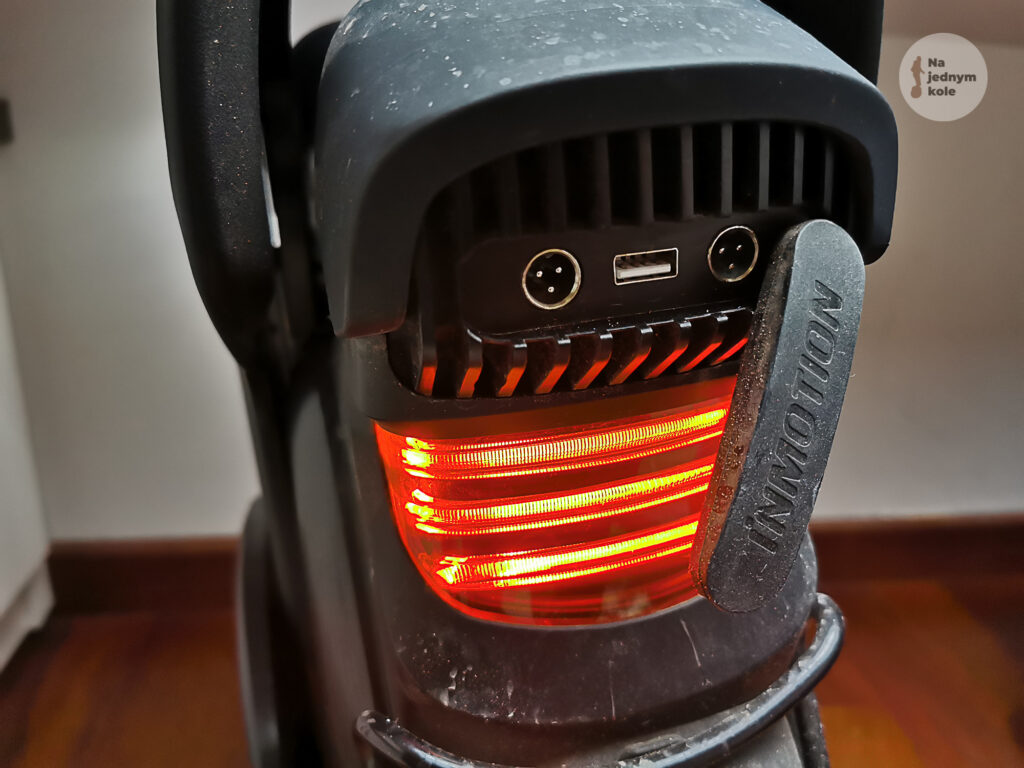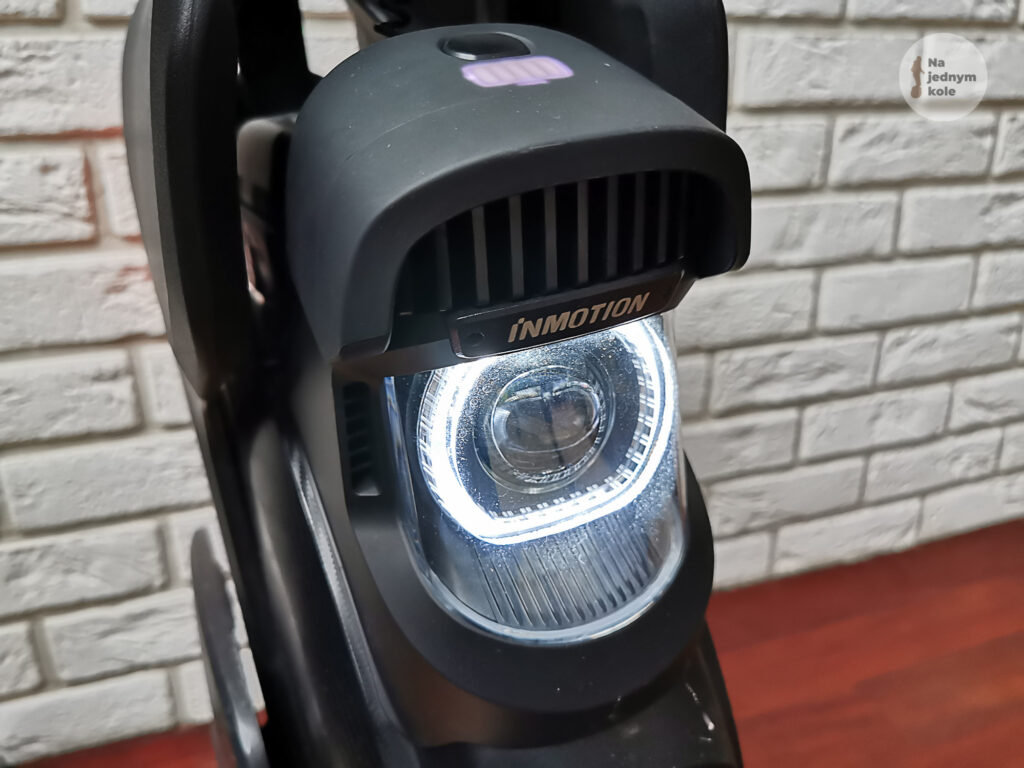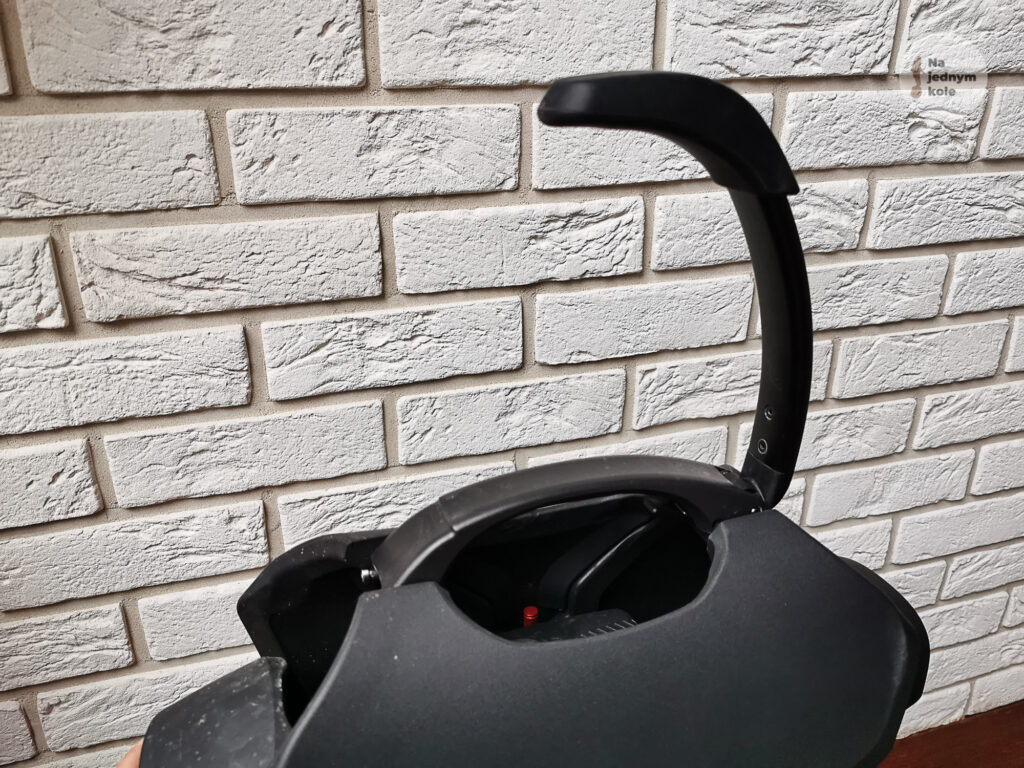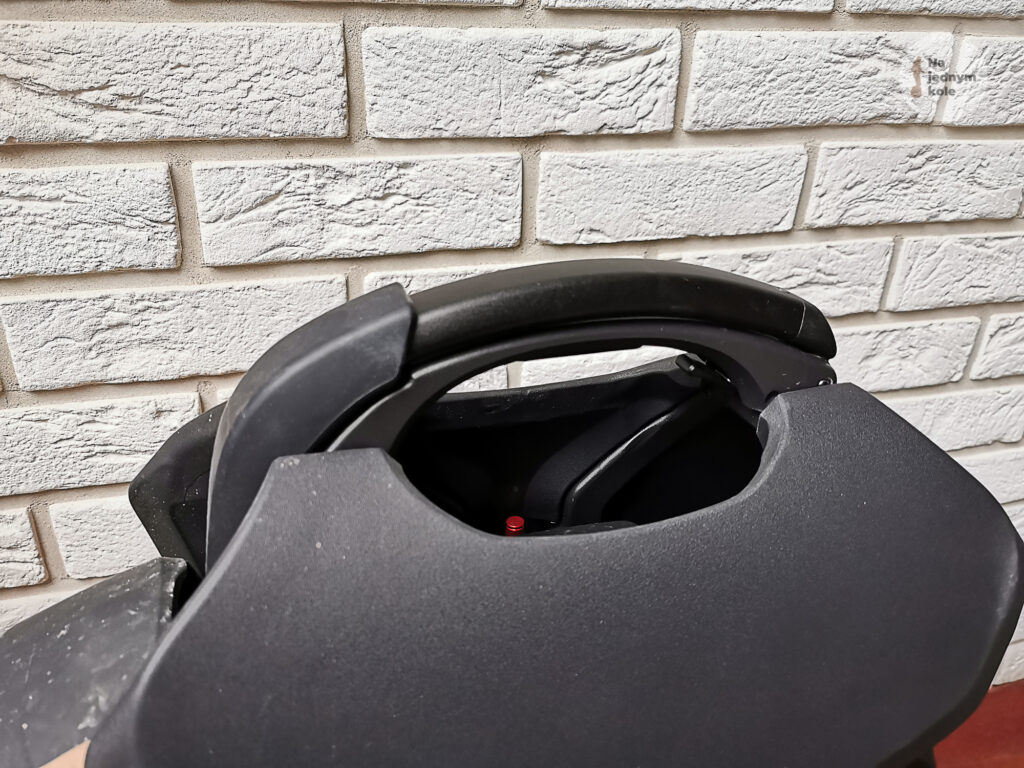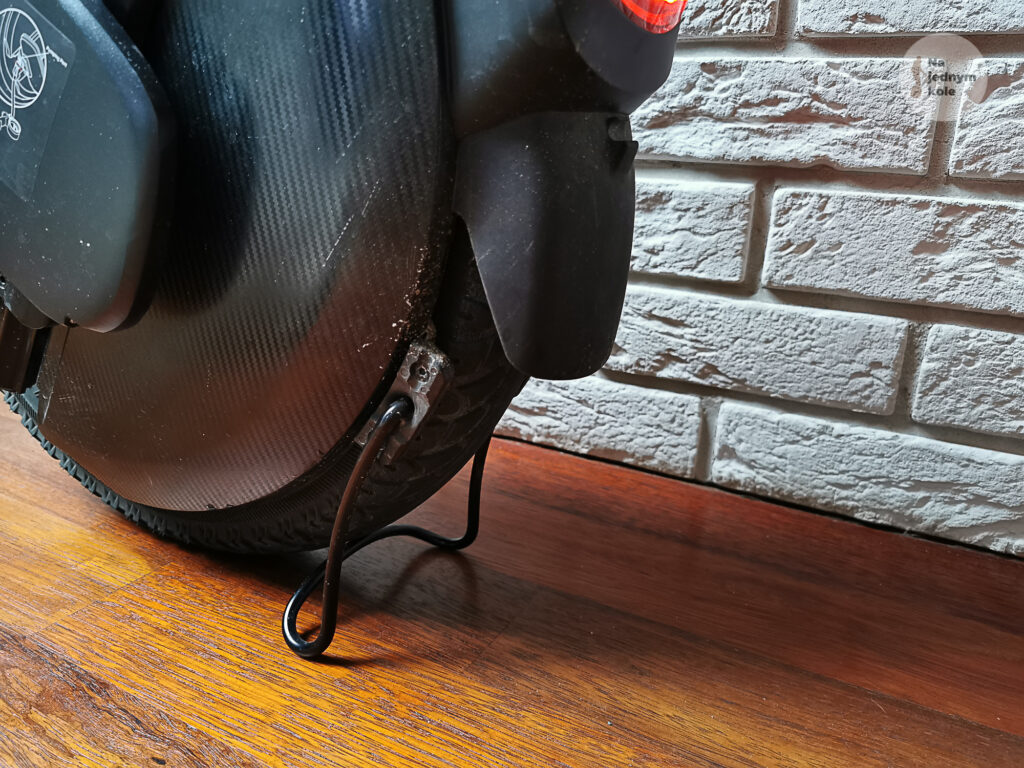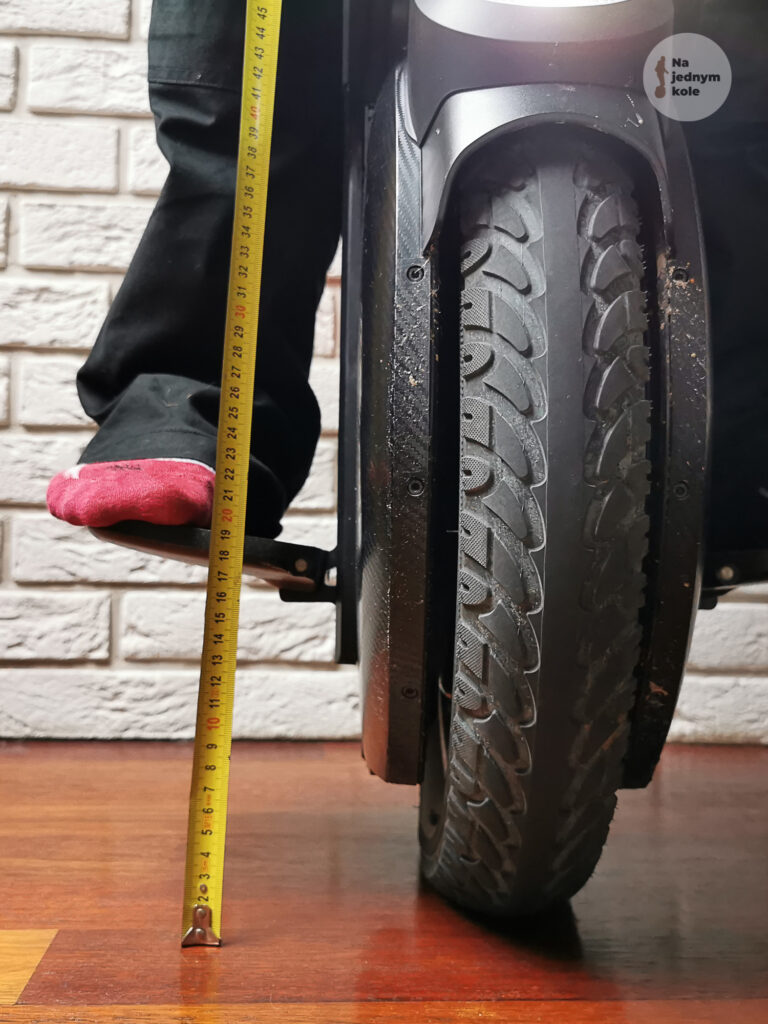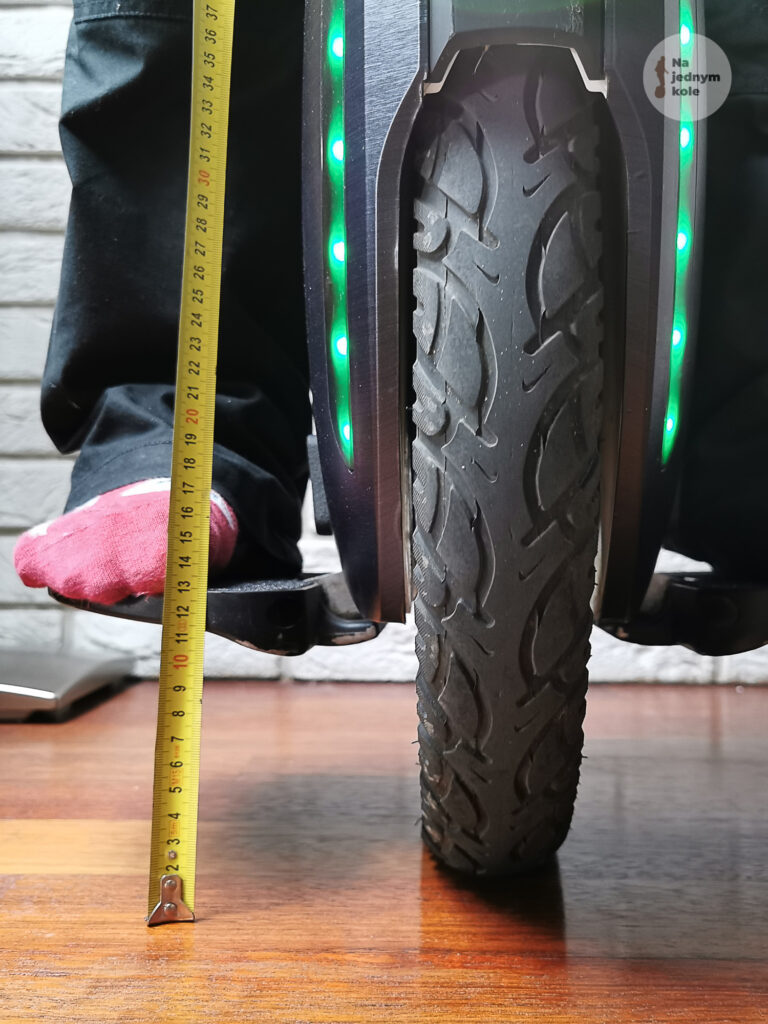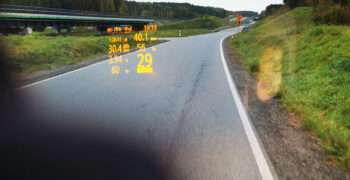V11 vs KS-18XL. A long-distance test of InMotion’s suspended wheel.
The Inmotion V11 is the world’s first suspension electric unicycle, and it’s also one of two suspension wheels launched in 2020. The other, of course, is the King Song KS-S18, which was shown literally days after the official presentation of the V11. While the two models have in common the fact that they are the first-ever mass-produced suspension wheels, they are pretty different from each other.
I had the opportunity to ride over 1,200 kilometers on the Inmotion V11 in the late summer and fall of 2020. In the blazing sun and in the pouring rain. In the warm August air and in the chill of late September. On even asphalt, as well as on potholes. On concrete and cobblestones of various textures and sizes. On gravel, sand and finally wilderness full of mud. Finally on meadows and stubble fields. There were even rocky mountain enduro trails. I rode the first 500 kilometers on a unicycle made available for testing by an authorised Polish Inmotion dealer – Eunicycles.eu. It was a wheel from the first production batch, which previously served as a demonstration wheel. The rest of the test I rode on my own V11, which comes from the second batch.
In this article, I’ll discuss the details of the V11’s design, share my experiences and riding impressions. I will highlight the strengths and weaknesses of this wheel, as well as compare it to the King Song KS-18XL.
Why InMotion V11?
I love long distance tours on one wheel of an electric unicycle. Whenever I have a chance, I pack my backpack and set off for multi-day trips all over my country. It does not matter if it is only two days or two weeks. Each day of such expedition means one hundred to two hundred kilometers of riding on various terrains and in various weather conditions. Regardless, the electric unicycle is for me the dominant way of getting around my city and its surroundings. I use my wheel almost every day and all year round, regardless of the season and the weather outside. So I need a wheel with a very versatile character. Without a reasonably capacious battery and the possibility of fast charging, there is no point in going on long journeys. Decent lights allow to see and be seen, which translates into greater safety while riding and the possibility of riding after dark. Possibly low weight and high ergonomics facilitate the use of the wheel. And finally, resistance to difficult weather conditions. Rain, puddles, snow or slush – my wheel must be prepared to ride in all conditions. You don’t choose the weather, after all.
Until now, my wheel of choice, meeting all the above criteria, was the King Song KS-18XL. On that wheel I rode thousands of kilometers within the last two years. I rode Poland on it from north to south. It bravely accompanied me during a two-week expedition along the Green Velo trail – longest Polish bike trail. I rode the entire Polish coastline on it – from city of Swinoujscie to city of Krynica Morska. Not to mention a whole bunch of shorter, just a few days expeditions. King Song KS-18XL did not let me down in the most difficult moments. When storms ravaged villages and towns in southeast of Poland, when super-duper hi-tech membrane jackets and pants for “a million bucks” failed and from morning to evening I had to ride fully wet, my XL bravely coped despite the heavy rain. In fact, we even got to wade through the waters of the San River, which flooded the only available road on my route. King Song KS-18XL is a wheel, which battery capacity of 1554 Wh allowed to cover from 70 to 100 kilometers in one go. After that, a two-hour 9 amp charging was enough to give the battery enough energy to ride another 60 to 80 kilometers. The eighteen-inch wide, two-and-a-half-inch wide tire handled like a dream, offering decent grip on almost any surface. Only mud and mounded sand made it safer to get off the wheel and avoid the problematic section of road by guiding the wheel by the convenient telescoping handle. Bright lights made me see and be visible. And finally the weight. Despite the fact that the XL weighs about 24 kilograms, its shape and extremely comfortable handle meant that carrying the wheel on the second or even third floor of a historic hotel without an elevator was not too much of a problem. The same applied to carrying the wheel over obstacles or lugging it up stairs. Yes, it’s not uncommon on the trail to run into obstacles that can’t be ridden.
As Inmotion and King Song unveiled their new suspension wheels, it was the V11 that caught my eye. At first glance, I saw it shared many features with the KS-18XL. Comparable battery capacity made me assume that both wheels would offer comparable range on a single charge. Sensational car-type lights guaranteed being visible and being able to ride after dusk without blinding others. Large pedals, slim and ergonomic design gave a chance that the change from an XL will be relatively painless. And finally, the rain resistance declared by Inmotion – an absolutely indispensable condition for a universal or expedition wheel. I also liked the original design, but of course this is a matter of personal taste.
When, together with Eunicycles.eu, I organized a presentation of both suspension wheels in Gdańsk, Poland, my interest in V11 grew even more. A closer contact with the S18 meant that, this time, King Song’s product did not impressed me. From my perspective, the V11 was superior to its competitor in almost every way. Better working suspension of the S18 did not compensate for other shortcomings of this wheel. As the future showed, the build quality of the King Song’s wheel suspension components limited the ability to exploit this design’s advantage over the V11. The biggest limitation of S18 turned out to be the 1100 Wh battery, which is not much more than in the case of KS-18L or Inmotion V10F. At a time when 1600 – 1800 Wh capacity is the norm, using such a small battery is quite a step backwards. It’s a shame, especially since King Song had already found out that equipping the KS-18L with a 1036 Wh battery was a mistake.
Shortly after that presentation, courtesy of Eunicycles.eu I could once again get acquainted with V11, and in particular put it to a long-distance test. It was also an opportunity to enrich the EUC World application with the possibility of working with the then youngest child of Inmotion. The most important part of the test took place on the route from Bydgoszcz to the Sowie Mountains. The three-day tour ended after driving more than 420 kilometers, but that did not mean the end of the tests. Hot, August days and steep mountain roads and trails let me see if V11 is able to cope with more demanding trails.
After returning from that trail I made the decision to buy the V11. The wheel, this time my own, arrived at the end of the first decade of September. Since then I managed to ride 700 km on it, including 300 km on the roads and wilderness of Warmia, Mazury, Kujawy and Mazowsze provinces. The September route was accompanied by completely different conditions than the ones I had in August. The first weekend of astronomical autumn brought me considerable temperature fluctuations, strong headwind and intensive rain. Thanks to those “inconveniences” I was able to gather the missing experience and finally find out how the V11 handles riding in the pouring rain and streams of water from the wheels of passing cars. After that tour, I was ready to get down to writing this article. So let’s start by looking at the details of the unicycle.
Tire
The Inmotion V11 is equipped with an eighteen-inch wheel that comes standard with a three-inch wide tire. This is the gold standard for a balanced combination of the following characteristics – good grip, good steering precision, and good rim protection from damage when hitting a curb or a hole in the asphalt. Use of 18×3 tires also allows the use of motorcycle tires in the 80/80-14 size, which is good because you can find quite a few interesting tires in this size, including winter tires or tires designed for cross country. This is especially important for those who enjoy riding in slightly more challenging terrain. As in other wheels, V11 tire is not tubeless. Due to V11 design, to inflate the tire you will need a special “extension adapter” , which of course you get with the wheel. It is a good idea to get a second one for spare, so you can always have one with you.
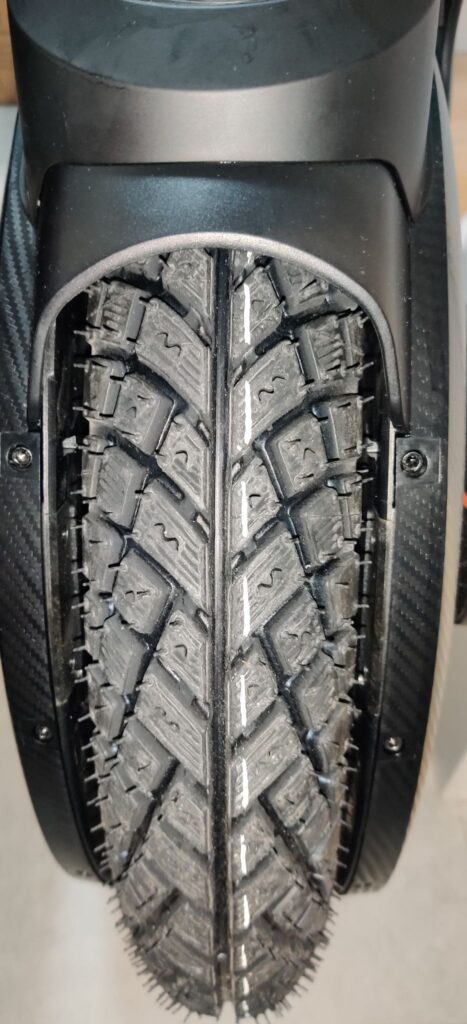
Winter, motorcycle 80/80-14 tire that can be used with V11. Photo: Artem Maistrenko 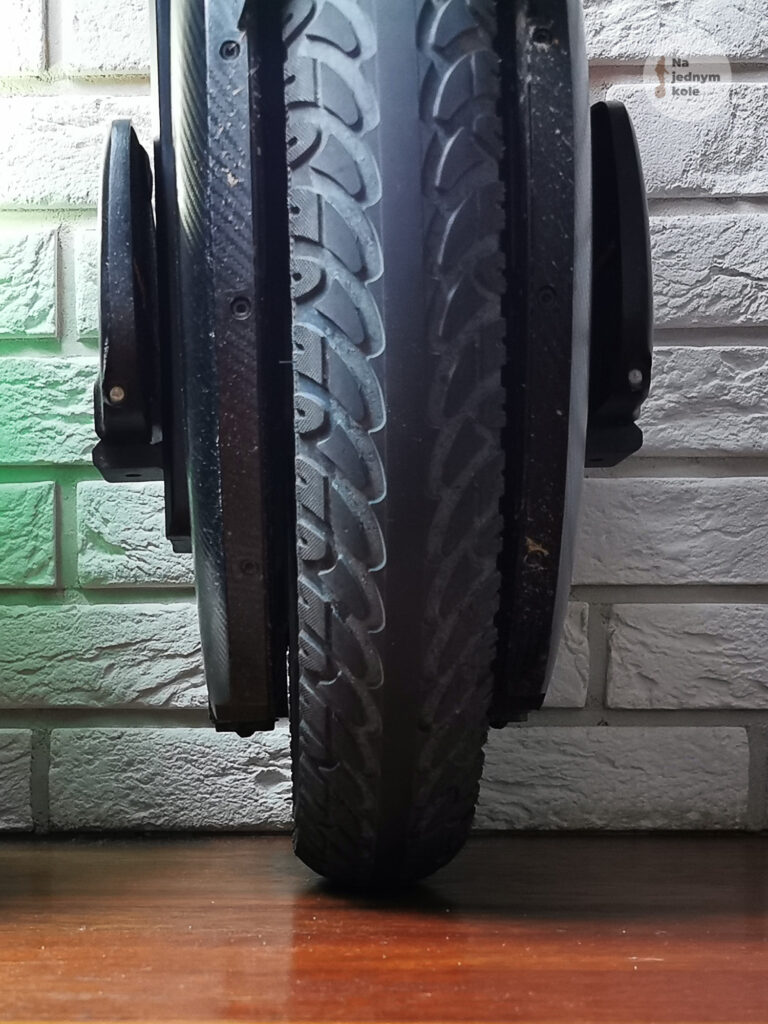
Standard CST C-1488 tire
Battery
The V11 is equipped with a 1456 Wh battery. It is made up of two identical, self-contained modules with a capacity of 728 Wh each. Each module is enclosed in a sealed case, which, according to the manufacturer’s claims, meets IP67 requirements. The battery voltage is 84 V, and a total of eighty LG INR21700-M50T cells (forty cells per module) were used to build it. Such a battery has a 20S4P configuration, which when confronted with the cell data sheet tells us that this battery has been sized exactly to the motor used in terms of allowable load. In other words, it is capable of delivering about 2000 watts of continuous power, which roughly matches the rated power of the motor used. Each module is independent from another. This means that if one module fails, the wheel can continue to ride safely using the other, working module. The module’s BMS communicates with the motherboard via two additional pins in which the XT90I high-current connector is equipped. Battery charging is done via two sockets, available under the rubber cap above the tail light. There is also one USB socket. Officially, Inmotion allows the V11 to be charged with up to 5 A, which is due to the possibility of simultaneous use of two chargers, each of which has a current capacity of 2.5 A. 5 A is not enough to efficiently and quickly recharge during a stop on a long trip. I have successfully charged the V11 with 7 amps many times using my fast travel charger. However, I did it on my own responsibility and so far I do not recommend this solution to anyone until appropriate tests are conducted. I charged XL with 9 A, which shortened the charging intervals even more, without damaging the battery life. In the case of V11, reading the data sheet of the cells used leads to the conclusion that 6 A can be used if the temperature of the cells is lower than 25°C.
The battery allows discharging up to 66 V, i.e. 3.3 V per cell. When this threshold was reached, the low battery mode was activated and the unicycle, with a rather quick tiltback, forced the rider to stop and get off the wheel. At this point, it was possible to activate the additional reserve (via the app). This has changed in recent 1.2.22 firmware, so you can permamently enable riding under low battery condition. Unfortunately, once the battery level goes below 15%, further riding is severely hampered. In the mountain part of the test, this meant the inability to continue riding up the slope – wheel was constantly tilting back. Very disappointing experience, as with King Song you can continue your ride with lower speed.
Motor
The rated motor power is 2200 watts, which is typical for a top-of-the-line eighteen-inch wheel. The same motor power is used in the King Song S18 and 18XL. The electronic motor control system allows the motor to be temporarily overloaded to as much as 5000 watts. Interestingly, Inmotion was the first to use a hollow motor in the V11. Using a hollow shaft means less risk of damage to the shaft, more rigidity, and – in theory – less weight for the motor. The use of a hollow shaft also means that larger bearings are required – in the case of V11 tested, size 6816. The first series used Z-series bearings (with a stainless steel ring), which, as it soon became clear, did not provide adequate watertightness and riding in the rain resulted in water seeping into the motor. The manufacturer quickly changed the type of bearing used, and from the second series onwards, 2RS type bearings were used, with rubber seals on both sides.
Unfortunately, regardless of the manufacturer’s efforts, the idea of using a hollow motor was a failure. The new engines did not reduce wheel weight, instead they proved to be a source of failure. For the V12 model, Inmotion returned to traditional, proven solutions.
Electronics
In fact, in V11 we will not find a typical motherboard. Instead, we find a “sandwich” consisting of two separate boards – the inverter, i.e. the circuit responsible for controlling the motor, and the controller, i.e. the circuit responsible for everything else. This solution is a bit more complex, but it separates two fundamentally different circuits – the high-voltage and high-current motor control circuit from the sensitive controller, which does not like either high voltage or high currents and the interferences they cause. Furthermore, if the inverter is damaged, only this part needs to be replaced. So despite the higher degree of complication, the advantages outweigh the disadvantages. Due to the fact that the metal box in which both boards are enclosed is a classic Faraday cage (and thus does not allow for the penetration of radio waves), the circuit responsible for Bluetooth communication is integrated into the front lamp circuit. What is important, placing this chip in the lamp and using Bluetooth 5.0 technology means a long range of connection. This is useful on the road, as it allows you to remotely monitor the process of charging the wheel even a few dozen meters away.
The inverter is equipped with twelve MOSFET transistors in a TO-220 case. They are mounted to the base of the aluminum housing. The base is not only a mounting base but also serves as a heat sink which dissipates heat from the MOSFETs. The heat is dissipated in two ways. First, the lower part of the base is exposed to the inside of the wheel chamber. An identical solution is used by King Song in their unicycles. This allows the whole thing to be cooled very effectively by the air rush generated by the movement of the tire. When riding on wet pavement, the water droplets splashing through the tire significantly increase the effectiveness of this cooling. Secondly, the metal casing cover is involved in the cooling. It is swept by the air caused by the motion of the unicycle. When the temperature of the MOSFET transistors exceeds 60 °C, the fan located in the headlamp unit starts operating. Airstream generated by the fan not only cools the headlight LED, but also forces air around the cover, cooling it and through it also the base. The connection between the cover and the base is sealed with heat conductive sealant. Therefore, it is important to remember that if you need to remove the cover (for example, when changing a tire or when you need to disconnect the motor cables from the inverter), you must reuse the heat conducting sealant when installing the cover. This can be Krylex KSC1202 for example.
Lights
Looking at the V11 immediately brings to mind the lights used in modern cars. This is no coincidence – Inmotion officially refers to the lights of this unicycle as automotive-grade. I must admit that there is no exaggeration in this. The front lamp is equipped with LED emitter with a power of as much as 18 W, which translates into a luminous flux of over 2200 lumens, and the total brightness of the lamp is an impressive 4800 lux. The light beam has excellent geometry. It is wide, and the horizontal cut-off line is very sharp. This means that when riding on a level surface, the light will illuminate the road in front of the unicycle very clearly while not blinding oncoming car drivers or walking pedestrians. The lens of the front light is surrounded by an illuminated ring, which serves as a daytime running light. The solution known from modern cars is not only functional, but also gives the wheel a bit of prestige. Due to the rather high power of the emitter, the lamp requires active cooling. It is realized by the fan which turns on after the headlight is turned on. The fan is quite loud, which can be a bit disturbing. The solution to this problem is to activate the silent mode. It works by turning off the fan and simultaneously reducing the power of the front lamp, as long as the unicycle is not moving. When you start riding, the fan is switched on and the lamp returns to full power. It’s simple, but effective. While riding, the noise of the fan is largely masked by the noise of the wind and rolling tire.

Comparision of KS-18XL (left) and Inmotion V11 (right) headlight as projected on the wall.
The rear red light also deserves praise. It is large and visible from a distance. When the headlight or daytime running light is on, the red light acts as a regular tail light. When braking, this light comes on with increased intensity, acting as a stop light.
These are all the lights the V11 is equipped with. You will not find here any side, multi-colored rings or any colored lights at all (neither are the single-colored ones, except of battery level indicator). For some people it will be an advantage, others may feel a bit disappointed. I belong to the first ones – V11 is a very elegant wheel and in my opinion colored lights would spoil its consistent design. Certainly the V11 is a wheel whose lights meet the requirements for bicycle lighting.
Suspension
It’s time for what is one of the key features of the V11 – suspension. Inmotion chose a more conservative solution than King Song. The V11 is suspended only by the part that is in contact with the body of the rider: the pedals, the “saddle” and the handle. All the rest is mounted traditionally – rigidly to the wheel axle. This increases the unsprung mass, which generally translates into worse riding characteristics. A practical comparison of the V11 and S18 unicycles confirms the superiority of the S18 in this regard, but the difference is not as big as one might think. The S18’s suspension works a bit better and it also offers significantly more adjustability. In the case of the V11, adjustability is limited, but the damping works quite decently. The S18’s better damping and suspension performance comes at the price of greater complexity.
The S18 uses a single, central shock absorber, as used in full suspension bikes. This means more adjustability and easier adjustment. The use of a standard shock absorber also means it can be replaced. The V11 uses two independent shocks. This means a bit more handling, as the pressures on both sides must be identical. The shock absorber itself is a non-standard design, according to Inmotion, custom manufactured for them. The company does not reveal any details, and despite the efforts of many users, it has not yet been possible to find a replacement.
The shock absorbers used on the V11 have two Schrader-type air valves, used to inflate the lower (positive) and upper (negative) chambers. While the lower chamber valve is fairly easy to access, to inflate the upper chamber you have to remove the side “saddle” components. This is not difficult, but certainly requires more effort than in the case of S18. Officially Inmotion does not mention necessity of inflating upper chamber. In the manual, as well as on a special sticker on one of the pedals, only recommended pressures in the lower chamber are indicated, according to the user’s weight. However, on many forums it is written that the recommended pressure in the upper chamber is 50 psi. Many users experiment with shock chamber pressures and post their own recommendations. In my experience, however, limiting myself to the lower chambers is completely sufficient. What’s more, when I was experimenting with pressures in my test V11, I was not able to get satisfactory results. When I thought I found the optimal setting, after an hour of riding it was completely different. After three days of experimenting I gave up, although I learned some lessons for the future. So when my own wheel arrived later, I decided not to touch the upper chambers at all. Since the lower chambers are depressurized for transport, after unpacking the wheel it is necessary to fill them up. This is done with the included shock pump, quite decent and functional by the way. Since I weigh between 90 and 110 kilograms (including my gear), I decided to inflate the lower shock chambers to 120 psi. This was enough to get a fully satisfying result. Importantly, I haven’t touched the shocks since, and their characteristics are still the same. For now, I’m not going to mess it up.
Ergonomics
I have to admit that Inmotion put a lot of attention into the design and created a wheel that is really hard to fault. The V11 is narrow and quite tall, which doesn’t mean its center of gravity is too high. The pedals are large and offer really solid clearance. Their top part is entirely covered with a grip tape, exactly like in the “big” King Song 18XL pedals. The pedals are inclined slightly inward, at an angle of about 9°. It’s not as steep an incline as the Gotway/Begode wheels, but neither are the pedals horizontal like King Song’s. This has its pluses, it also has its minuses. Overall, it is something to get used to.
Inmotion in the V11 has used the same kind of handle we know from the V10, but here it is much more refined. This time the handle doesn’t look like a dildo reworked for other uses, but instead blends in well with the rest of the wheel design. The handle is flat, more solid, visually integrated into the handle and finished with a rubber element. It unfolds when the lock is released using a lock hidden underneath the handle. When raised, the handle is stiff enough to allow for stable wheel guidance. Although the King Song’s telescopic handle is still more comfortable, I rate the solution used in the V11 higher overall. Why? The telescopic handle mechanism in the King Songs gets dirty quite quickly, the telescopic elements become loose and the operation of the whole thing becomes less and less reliable. Meanwhile, the handle in the V11 is a simple but solid solution. When raised, the grip is high enough that for most people there will be no problem guiding the wheel without having to hunch over. Also, the wheel lift sensor in King Song’s is something that may work or not, especially after riding in the rain. No, I’m not talking about the old sensors at all. The new ones also have their moods, including refusing to work after riding in the rain. Meanwhile, the button under the handle of the V11 is perhaps a more primitive solution, but it has the advantage that it works. And it always works.
On the top of the front lamp is a convenient power switch that also functions as a light switch. A battery level indicator and indicator lights are also located there. The blue one indicates an active Bluetooth connection, and the red one a malfunction. Above the rear light there are two charging sockets and a USB socket. The sockets are covered with a rubber cap, which well protects the sockets from dust and water. Of course if you don’t forget to close the cap after charging…
Weight
The Inmotion V11 weighs 28 kilograms. That’s four kilograms more than the King Song KS-18XL, and I have to admit that the difference is quite noticeable. Admittedly, the V11’s slimness means that carrying this unicycle doesn’t mean bumping it against your thighs and calves. The considerable weight, however, can be felt and must be taken into account. If you are of rather small build and your muscles are not used to carrying weights, the V11 may prove to be too heavy a wheel. The King Song S18 is slightly lighter, but this has been achieved at the cost of a 25% reduction in battery capacity. And it is still a wheel that actually weighs 25 kilograms instead of the originally declared 21 kilograms.
Mudguard and kickstand
I would like to draw your attention to a solution which was previously unseen in our wheels – an integrated kickstand. It is a simple but very practical solution. It allows leaning the unicycle directly on the ground. To do this, simply unfold the stand, which is normally folded over a rubber flap. In this position it is solidly held by three clasps – two on the sides and one on the upper part of the mudguard. When the kickstand is unfolded and the button under the handle is pressed, the unicycle can be rested on the kickstand. The motor does not activate in this position, so the wheel can be left on all the time. However, simply straighten up the unicycle and the stabilisation will be gently engaged. Simply fold up the stand and go on your way. It’s a wonder that nobody thought of this before.
However, the stand is not an ideal solution that will work in all conditions. Stability of the wheel resting on it is quite limited, and it can be used only on a perfectly horizontal surface. Even a slight incline excludes the possibility of using the kickstand and then the traditional solution remains – leaning the wheel against a tree, bench, wall or simply laying it on the side. But even on a horizontal surface it may happen that a gust of wind will cause the wheel to fall in the side. Nevertheless, the kickstand is a very useful solution, especially when you have to stop to seek relief in nearby bushes.
Riding impressions
First impression after switching from KS-18XL to V11:
– Boy, how jerky that wheel is!
Moments later, the second impression was:
– Oh shit, plus it’s lazy….
This was obviously a consequence of two key differences. First, you stand higher on the V11 than you do on the KS-18XL. Second, the wider V11 tire, on the one hand, is less sensitive to the efforts of the rider, but on the other, it yields more easily to the unevenness of the road surface. Fortunately, I got used to the specifics of the V11 very quickly. After a few dozen kilometers of riding, the differences between those two wheels disappeared to a large extent, and on the V11 I rode almost as good as on the XL. Almost, because riding on a pavement built of chamfered cobblestones required increased attention and constant correction of the direction of travel. On the other hand, riding on potholes and off-road – awesome!
I deliberately planned the route of the first test expedition in such a way that part of it led along poor roads or even no roads at all. As a result, just outside of city of Bydgoszcz I could see how useful the suspension is on a unicycle. When I had to ride through a meadow, I could not worry about molehills hidden in the grass, or other surprises. In addition, the wider tire had less tendency to sink into loose soil, so in the end riding through that meadow was quite pleasant. When I reached the Notec Canal embankment on the way to the sluice in Debink, and it turned out that the planned route was overgrown by high weeds, I had to improvise. This meant continuing the ride across a meadow and then entering a dirt road. The V11 coped bravely everywhere, and the further road to the lock proved to be very pleasant. Really, in such cases, the cushioning does the job. Not to be overlooked is the fact that the inclined pedals and the relatively high pedal clearance made it possible to avoid getting stuck in ruts on slopes or protruding rocks or tree roots. On another occasion I was forced to drive through a freshly plowed field because the dirt road next to it had been turned into a swamp by rain and farm machinery. Here, too, the V11 showed its class.
One would expect, then, that the suspension would ease the burden on the rider and make the ride less tiring. Unfortunately, at least in my case, this is not the case. First of all, because the suspension does not relieve the rider of the need to work on bent legs. It still requires the rider’s cooperation and riding with legs bent at the knees, while the suspension has a supporting effect. However, it is a very useful aid that can save you from a fall if you accidentally ride into a pothole, large rock, curb or other obstacle. Suspension does not make riding less tiring. It does, however, make riding over bumps easier and safer. So while the V11 suspension is far from the comfort known from the cult Citroen models with hydropneumatic suspension, it is effective enough.
Acceleration and braking
I have slightly more complaints about the way the wheel accelerates and brakes. Around since firmware version 1.13, the KS-18XL became a much more nimble wheel that was very close to comparable Gotway/Begode wheels in terms of braking and acceleration. Meanwhile, on the V11, I feel that braking in particular is less effective here. Changing the riding mode settings or turning on high performance mode doesn’t change much. This is certainly influenced by the increased weight of the wheel, as well as the high pedals. Also my riding style certainly doesn’t help here, as I ride with my feet quite wide apart and use only my feet to transfer forces to the wheel. I still need to adapt to effective use of power pads, however I have to say that Frank Chessa custom power pads are a masterpiece.
Anyway, I’m afraid acceleration limitations are something we have to get used to. The characteristics of this wheel make it susceptible to inverter damage when overloaded by trying to accelerate hard. MOSFETs enclosed in TO-220 case doesn’t help to overcome current or power dissipation limits under high load.
Mountain test
The trip to the Sowie Mountains was a perfect opportunity to test how the V11 handles steep climbs. We are all familiar with Marty Backe’s tests, where he climbs long and steep mountain slopes to test the overheating and overloading resistance of various wheels. In the case of the V11, the test came back negative, but interestingly, the wheel failed not while riding uphill, but during a break. The wheel Marty tested, however, was from a pre-production run and, as Inmotion admitted, had some defects that were corrected in the production models. The wheel made available to me for testing by Eunicycles.eu was already from the production batch, and the opportunity for a “mountain test” came before I even reached the Sowie Mountains. After passing city of Wroclaw, on the left side of my route, something big and triangular emerged on the horizon, calling from afar: “- Seeebaaaa, ride in on me…”. It was the voice of Ślęza, and as it is a sin to refuse a woman, I decided to fulfill her wish. Despite the low relative height, the difference between the foot and the summit is about 500 meters. Even if “Overheat Hill” is bigger, the ascent to the top of Ślęża will tell enough about the real capabilities of the wheel.
I rode up Ślęża in a typical way, using the yellow trail – the shortest way on foot from the Tąpadła Pass to the top. The ascent was not the easiest one, as the road was very uneven and full of rocks, which popped out from under the tire edge when I ran over it. I had to watch out for tourists going up and down, which meant relatively slow riding, intense muscle work, and pushing myself to the limits to keep my balance. Already in one third of the ascent I was sweating no less than those who entered on foot. Very soon, EUC World started warning me about the risk of overheating the wheel, as my temperature alarm was set to 60 °C. Nevertheless, I continued riding knowing that this was a very conservative value and in fact the actual overheating should have been informed by the unicycle itself. I just hoped that this information would come in a civilized form, giving me a chance and time to react. I remembered Marty, for whom testing some wheels ended with a sudden fall to the ground. So I rode on, despite the constant alarms generated by EUC World. Eventually I made it to the top without bad adventures, but also without alarms from the wheel itself. At the peaks, the motherboard temperature exceeded 90 °C at times.
This experience encouraged me to another test, which took place a few days later, on the route from Sokolec village to the Eagle Mountain Hostel near Wielka Sowa hill. Here, too, V11 managed to get in without a problem, even though the temperature of the MOSFETs reached 115 °C. Since it was the middle of August, the temperature outside reached 30 °C. These experiences reassured me that in everyday use, the V11 can cope with climbing quite steep hills. As I wrote, perhaps Marty’s test hill was steeper and longer, but let’s answer the question – are these the conditions for normal, everyday wheel use? From my perspective, the V11 passed the mountain test. Especially when I had to ride on rocky MTB trails around the Goat Saddle Pass. It was greatly helped by the wide tire, high ground clearance and the suspension.
Imperfections
No wheel is perfect and the Inmotion V11 is no exception. First, a noticeable downside of the V11 is the relatively short range for the battery capacity used. It would seem that two 18-inch wheels – one with almost a 1500 Wh battery and the other with a 1554Wh battery – should offer similar range for the same rider and the same conditions. Meanwhile, the V11’s range is about 20 percent less than that of the KS-18XL. This is partly due to the higher rolling resistance of the wider tire, but also because the XL can be discharged as low as 3 volts per cell. The V11 allows the battery to be discharged to 3.3 volts per cell. In practice, this meant that 85 kilometers could be ridden under normal conditions. Strong headwinds meant that after just 50 kilometers you had to look around for a place to charge.
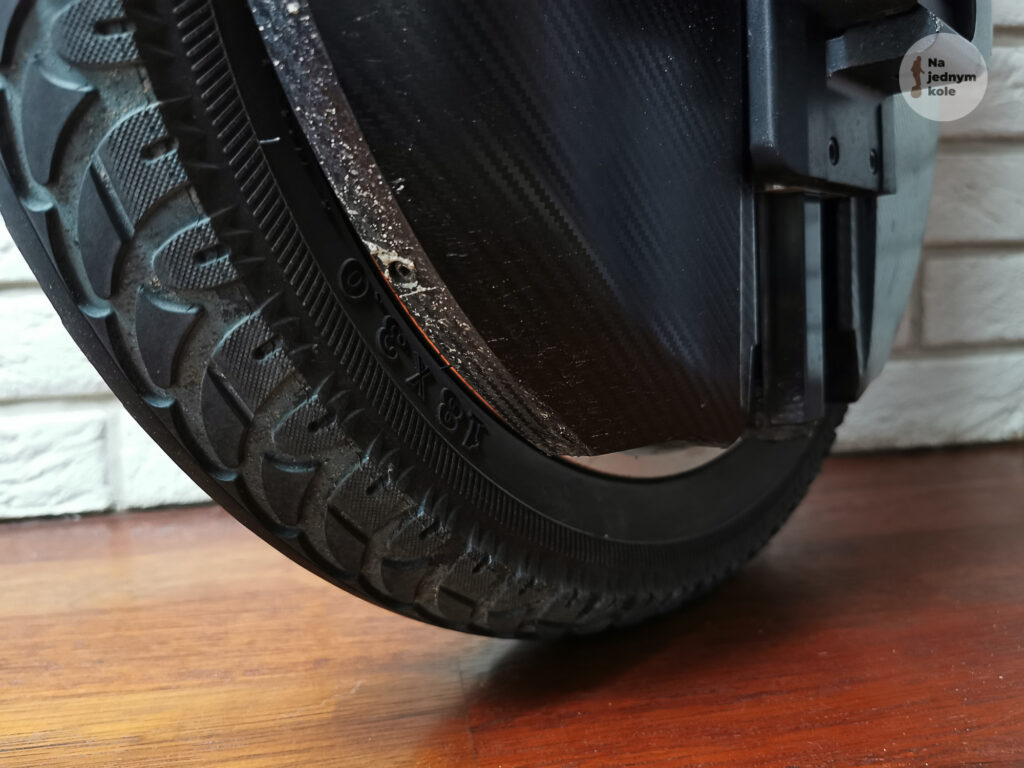
Even if the pedal clearance is high, it’s easy to scratch the bottom part of the side cover.
The batteries in the Inmotion V11 are located on both sides of the motor. As a result, the entire rim is covered and the bottom edge of the side cover is only 7 to 8 centimeters from the road surface. The lower edge of the shock cover is a centimeter lower. This means that when riding on rocky ground, there is a risk of a rock hitting the shock absorber cover and the lower part of the battery cover. What’s more, if you ride at a sharp angle onto a kerb or similar, there is a considerable risk of hitting the kerb with the edge of the side cover. This means scratching it, but you could also end up losing your balance. For this reason, it is best to ride onto kerbs and similar obstacles at right angles, at a limited speed.
Summary
V11 is a decent and very well designed wheel. It is also a wheel of revolutionary character. However, it is not without flaws. More than six months have passed since the test and I’ve ridden another few thousand kilometers. In the meantime I was forced to make a repair, caused by a sudden bearing failure. At the distance of just a few kilometers the bearing started to make noise and then blocked, making further riding impossible. Fortunately, I was riding in my city, few kilometers from home.
That is why today, without regret, I return to the KS-18XL, which has always faithfully served me in all my long and short trips. From time to time, however, I will get my V11 for a ride to the forest wilderness, where the suspension shows its power.
